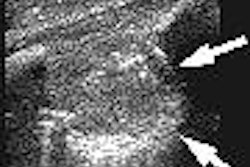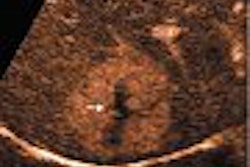The second-trimester fetal biparietal diameter/nasal bone length (BPD/NBL) ratio is a significant and independent predictor of trisomy 21, according to an article in the Journal of Ultrasound in Medicine.
"An assessment of the BPD/NBL ratio may improve the diagnosis of trisomy 21 when used with current prenatal screening practices," wrote researchers from the University of Washington in Seattle.
To evaluate the association between the second-trimester fetal BPD/NBL ratio and trisomy 21, the researchers identified 31 cases of trisomy 21 from the institution's prenatal diagnosis database that had complete ultrasound images including the nasal bone (JUM, June 2005, Vol. 24:6, pp. 811-815). These cases were then matched to 136 euploid fetuses based on maternal age, indication for referral, and gestational age.
For the fetuses with trisomy 21, the mean NBL was 2.3 mm ± 1.7 mm, compared with 3.9 ± 1.2 mm for euploid fetuses (p < 0.001). The median BPD/NBL ratio was 17.7 (range, 6.2-114), compared with 11.7 (range, 5.8-80) for euploid fetuses (p < 0.001).
The study team also found that the risks of trisomy 21 increased 2.4-fold (95% confidence interval [CI], 1.7-3.4) with every 1-mm decrease in NBL, and increased 1.08-fold (95% CI, 1.03-1.12) with each unit increase in the BPD/NBL ratio (p < 0.001).
From a multiple logistic regression model that included the BPD/NBL ratio, maternal indications (age 35 years, positive serum screening results, or both, yielding a risk of < 1 per 270 for trisomy 21), and sonographic markers as covariates, the BPD/NBL ratio was found to be an independent predictor of trisomy 21 (odds ratio, 1.08; 95% CI, 1.03-1.11).
The study team also discovered an improvement from an analysis of receiver operating characteristic (ROC) curves after the BPD/NBL ratio was added to a model containing the current second-trimester screening based on maternal age, serum screening, and sonographic markers.
The authors acknowledged limitations in their study, including its retrospective nature and the elimination of a large number of studies due to poor image quality. In addition, technological advances in imaging and resolution during the five-year duration of these studies may have affected caliper placement and the final nasal bone measurement, they stated.
The researchers also said that their results should be extrapolated to a general low-risk population with caution, as most of the women in the study had at least one risk factor for aneuploidy.
"Although our study found a considerable and independent association between the BPD/NBL ratio and trisomy 21, our ROC curve data should not be used to provide estimates of sensitivity and specificity for the general population because our study was not designed to test the BPD/NBL ratio as a screening tool," the authors wrote. "Furthermore, correlation to maternal ethnicity is required when applied to other multiethnic populations because previous studies have looked at the ratio in a predominantly white population. A higher incidence of absent nasal bone has been noted in the fetuses of mothers of African origin."
The researchers noted that their data and those of others support the addition of NBL to the list of soft markers for trisomy 21 screening in the second trimester.
"However, individual institutions may need to establish their own cutoff values, and perform separate validation studies for their prediction model to produce acceptable sensitivities and specificities within their population," the authors concluded. "Finally, although the addition of NBL statistically improves detection, it remains unclear whether this will translate to improved clinical benefit in a low-risk population.
By Erik L. Ridley
AuntMinnie.com staff writer
June 16, 2005
Related Reading
Ultrasound detects fetal aneuploidy with cord thickness measurements, October 21, 2004
Sequential screening program detects nearly all trisomy 21-affected pregnancies, October 11, 2004
Fetal trisomy 21 pregnancies linked with lower preeclampsia risk, May 1, 2004
First-trimester ultrasound Down screening offers savings -- but at a cost, February 6, 2003
Copyright © 2005 AuntMinnie.com




















